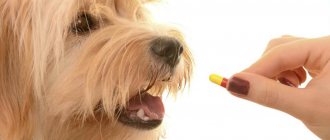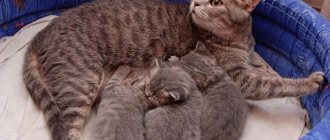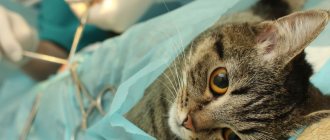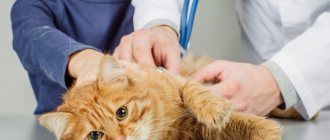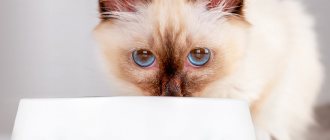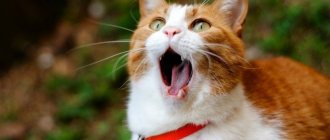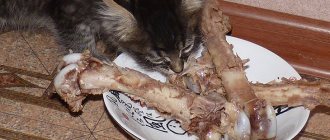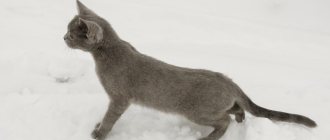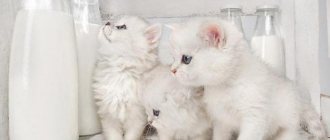Causes of lactation disorders in cats
Nature made sure that after childbirth, the mother first produces colostrum, and then milk.
The central nervous and endocrine systems of the body are responsible for these processes. Childbirth triggers the production of hormones that stimulate milk production (prolactin, oxytocin). Sucking the cubs stimulates the synthesis and flow of secretions into the mother's mammary gland. However, often the well-functioning natural mechanism malfunctions, and the animal produces little or no milk at all. There are many reasons why a cat does not produce milk after giving birth:
- Complications associated with lambing. Endometritis (inflammation of the uterine mucosa) and pyometra (purulent inflammation of the uterus) are difficult for the animal and are characterized by inflammatory processes and a febrile state. Against the background of these pathologies, milk production often stops. The cause of agalactia may be postpartum eclampsia, which develops due to calcium deficiency in the body.
- The retention of the placenta can be a factor inhibiting the processes of formation and flow of secretions into the mammary gland.
- Mastitis (inflammation of the mammary gland) is one of the common causes of insufficient milk production in a cat. The disease is accompanied by an increase in body temperature and a painful syndrome.
- Hormonal imbalances. Often the reason why a cat loses milk is hormonal imbalance. This often happens when an animal is mated early, when labor is delayed.
- Postpartum stress. Lambing for an animal, especially if the female is primiparous, is accompanied by psychological and physiological stress. Anxiety in the mother can be caused by increased human attention to the offspring, noise, bright light, and proximity to other animals. Stress suppresses the production of hormones responsible for lactation.
- Inadequate feeding. One of the common reasons why a cat has little milk is a low-calorie and unbalanced diet. The diet of a nursing mother should correspond to her physiological state and be high in calories.
- Congenital malformations can also cause agalactia and hypogalactia in cats.
READ DIY cat houses
If agalactia or insufficient milk production in a cat is detected, the animal should be shown to a veterinarian for diagnosis of diseases (mastitis, endometritis, pyometra, postpartum eclampsia). If a hormonal imbalance is detected in a cat, the veterinarian will prescribe hormonal therapy for the animal.
After dangerous factors have been eliminated, the owner’s task is to ensure proper nutrition and maintenance conditions for the nursing mother.
What should I do to make my cat produce milk? First of all, the mother must be protected from stressful situations, and a calm, secluded environment must be created for feeding and caring for the offspring. The nest should be placed in a dark, secluded place inaccessible to other animals.
The main thing in stimulating milk production is adequate feeding. A nursing cat should receive 2 times more calories compared to the normal state. The diet should include meat (beef, chicken, offal). It will provide kittens with the necessary protein and enhance milk synthesis. Dairy products (cottage cheese, cream, yogurt, fermented baked milk, cheese) also stimulate production. The animal's diet must include vegetables (carrots, cabbage), which have a stimulating effect on the mammary gland.
If a cat eats dry food, then it should be switched to premium and super-premium mixtures from well-known manufacturers. Specialized nutrition fully meets the physiological needs of a nursing mother. The bowl of food should be located near the cat’s nest, as many caring mothers are afraid to abandon their kittens for a long time and remain hungry.
To improve lactation, high fluid intake is important. It is better if the cat eats liquid food, for example, in the form of warm broth. Water should be freely available to the animal at all times.
Mastopathy
Chronic mastitis can cause mastopathy.
It is generally accepted that the main cause of mastopathy is hormonal disorders. However, this pathology can occur as a complication of chronic mastitis.
Clinical signs
The main symptoms are associated with enlarged mammary glands.
- The provoking cause, the factor of which is a stagnant process, is characterized by fibroepithelial hyperplasia of a diffuse form . The entire area increases in size with the presence of multiple compactions, and not only individual compactions are painful, but also the entire inflamed area. If ulcers begin to appear, help will be very difficult and the effectiveness of the prescribed treatment will remain in question.
If a cat is diagnosed with an advanced form of the disease, the only way to help it is through surgery.
A serious lesion entails surgical intervention with partial removal of the affected bags or a complete mastectomy , which implies removal of the uterus along with the ovaries.
Such a radical method is required when the form is advanced, when there is nothing else to help the pet.
In milder cases, iodine-containing drugs, anti-inflammatory drugs, homeopathic medicines, and immunomodulators are used.
Signs of underfed kittens
It is very important to detect in a timely manner that newborn kittens are not eating enough to prevent mortality and morbidity among the offspring. How can you tell if a cat doesn't have milk? The following signs that you need to pay attention to will help with this:
- When you press on the nipple, a drop of milk should appear. This manipulation needs to be done at the time of feeding, since the cat’s milk is not constantly in the mammary glands, but when the kittens stimulate the nipples. And if a drop of milk does not appear at this moment, it is worth taking a closer look at the kittens’ behavior.
- Hungry babies are restless, look for nipples, squeak, and do not sleep after feeding. Hungry or underfed kittens crawl around looking for a food source. Well-fed cubs fall asleep almost immediately after the next intake of milk, sometimes right at the mother's nipple.
- Some cats, if they do not have milk, are reluctant to be near kittens and abandon them. Other animals with agalactia continue to “feed” their offspring, take care of them, warm them, and lick them. In this case, the behavior of the kittens will be an indicator of underfeeding.
- More reliable information that a cat does not have enough milk can be obtained by regularly weighing the babies. During the day, with a normal supply of food, the cub gains at least 10 grams in weight. If within a few days the increase is less than this or is completely absent, this is a serious symptom that the kitten is starving and its life is under threat.
Kitten weight by month
| Kitten weight per month | 500-750 gr |
| Kitten weight at 2 months | 1000-1500 gr |
| Kitten weight at 3 months | 1700-2300 gr |
| Kitten weight at 4 months | 2500-3600 gr |
| Kitten weight at 5 months | 3100-4200 gr |
| Kitten weight at 6 months | 3500-4800 gr |
The presence of one, and even more so several of the listed signs of lack or lack of milk in a cat, is a signal for the owner to take immediate measures to stimulate lactation in the animal.
READ Causes and symptoms of miscarriage in cats
If the measures taken to stimulate lactation have not led to the desired result, the babies show signs of malnutrition, it is necessary to urgently switch to artificial feeding of the offspring. For these purposes, special dry formulas for newborns are produced. The finished composition is identical to mother's milk and does not cause digestive upset in babies.
In the absence of specialized formulas for feeding kittens, whole goat milk is suitable, as well as dry formulas for infants. Baby food must be diluted 1.5 times before use. Natural cow's milk is not suitable for feeding due to its low protein content compared to cat's milk. It often leads to intestinal disorders in the young.
A cat's lack of milk or its insufficient production can lead to underdevelopment of the offspring and their death. Recognizing the problem in time can save the health and life of the furballs. Most often, timely assistance from a nursing cat has a positive effect on increasing milk production. And only in rare cases does a person have to take care of feeding the offspring.
How to care for kittens if their mother abandoned them?
Please note that a cat who has gone into heat and has lost her milk will most likely abandon her kittens. Moreover, in the most unfavorable cases, she can simply eat them. If you want to save the babies’ lives, you will have to take on all the burdens of care. This applies not only to feeding: when raising cubs, you need to remember about numerous nuances, the observance of which determines both the health and life of the offspring.
First, examine the babies: remember that they are normally constantly moving and twitching, even when they have not yet learned to walk. If the kitten is not sleeping but looks lethargic and inactive, this is not good. In their sleep, kittens are quite calm and can practically not change the position of their body. When a baby is constantly spinning and meowing, it can mean two things: either it has some kind of health problem, or (more likely) it is very hungry.
In case you had to take on the responsibilities of a cat mother, make it a rule to examine your pets daily. Healthy young kittens have warm skin and small, round tummies (provided they are well fed). In addition, strong babies must have a strong, pronounced sucking reflex. As soon as you bring the nipple to their mouth, they immediately begin to draw milk from it. If there is no such reflex or it is poorly expressed, then the baby is very likely not viable. Of course, you can try to get out, but it is impossible to give any guarantee of success.
What to do?
To find out why a new mother does not have milk, you should take her to a veterinarian to rule out diseases and serious pathologies. But the first thing you need to do is take care of the kittens. After all, they cannot wait long.
There are special mixtures for feeding small kittens; they can be purchased at any pet store. If it is not possible to buy such food, cow's milk is also suitable, but it is advisable to mix it with chicken yolk and a small amount of vitamins for kittens. Kittens should be fed through a bottle with a small nipple.
If your pet ate dry food before giving birth, it should be switched to soft food for a while.
Pet stores sell special food for nursing cats; it contains everything necessary to stimulate lactation. It is recommended to make mixtures of glucose, yolk and cream; such a delicacy will increase milk flow.
Colostrum
On average, a cat's gestation period is 65 days. Lactation can begin a few days before birth or directly during labor. For the first few days, the cat feeds the offspring with colostrum, which differs in color and structure from milk.
Colostrum is a concentrate of fats, proteins, vitamins and antibodies. When kittens are born their intestines are sterile. Colostrum contains a high concentration of beneficial bacteria that colonize the intestines and help kittens digest milk. The color of colostrum can vary from cream to yellowish.
Question answer
The cat pushes the kittens away and does not allow them to suckle
This is observed if a nursing female has problems with the mammary gland, or when the mother cat herself decided to wean her offspring from breastfeeding. It is necessary to examine the cat's mammary glands. If there are no signs of disease, and the kittens are still not allowed to breastfeed, you should somewhat speed up the process of switching to solid food. It is necessary to ensure that the cat does not injure the kittens in the process of driving them away. It is better to seat them in different sleeping places yourself.
The cause may be a foreign smell from kittens. If babies are often held in your arms, have been stroked by hands after washing with strong-smelling soap, or their fur has absorbed the smell of perfume when cuddling them to the chest, the cat will not let them near you. It is necessary to put the kittens in their usual sleeping place so that they are “saturated” with the usual cat smell and everything will fall into place.
If kittens stop eating solid food after weaning
Perhaps this is how post-weaning stress manifests itself. It is necessary to be patient when starting to feed the kittens again with milk (from a syringe or saucer yourself), starting to introduce complementary foods with minimal portions.
The cat is looking for kittens after weaning and distribution
Weaning doesn't just take its toll on the kittens—cats are also stressed about losing their babies. Ideally, a cat is always left with one kitten until lactation completely subsides. If this is not possible, you can try two options - placing a toy in the sleeping area or distracting the cat at the moment when she begins to walk around the house and meow, clearly inviting her babies (give a treat, play, pick up, stroke, let out). and so on.). It takes time and patience from the owners until the cat gets used to being alone.
It is also advisable to replace the bedding in the sleeping box and move (or completely remove) it to another place.
After the kittens were weaned, feces began to be found everywhere.
While the babies are small and feed only on milk, the mother cat licks their tummy after eating, doing a kind of massage and licking the excreted primary feces and urine. Obviously, after switching to adult food, kittens' feces become more and more formed and look like adults. The cat no longer eats it. The period begins when kittens are trained to use the tray. If after some time you put the babies in the tray and wait for them to do their “natural” business, the feces will no longer be detected.
How does breast milk burn out?
The figurative expression “breast milk burnout” does not quite reflect the essence of the process. Popularly, milk burnout is understood as a decrease in its production, up to its complete stop. In medical practice, the phrase “breast milk burnout” is used only in the case of acute mastitis, with high fever and severe course, which results in a decrease or reduction in the production of human milk. The general public knows exactly the first meaning; “burnt out” for most mothers means “disappeared.”
More than one scientific article has been written about how breast milk burns out; from a physiological point of view, this process looks like this.
The lactation process is controlled by two hormones: prolactin (responsible for milk production) and oxytocin (responsible for the release of milk from the breast). Lactation occurs according to the principle “the higher the demand, the higher the supply.” By the same principle, breast milk burns out - “the lower the demand, the lower the supply.” When a woman reduces the number of feedings, the levels of prolactin and oxytocin decrease, and breast milk is produced and released in smaller quantities. Subsequent reductions in feedings further reduce hormone levels, until the breast milk completely burns out.
No doctor can say exactly how long it takes for breast milk to burn out. Lactation processes are very individual. Some women forget that there was milk in their breasts just a week after the end of feeding, while others continue to secrete drops of it for two years after weaning.
To the question of worried mothers: “How many days does breast milk burn out?”, the answer can still be given, but it is slightly ambiguous. Theoretically, the feeling of breast fullness and minor pain should last no more than a week after the correct (!) end of breastfeeding. And here
The birth of kittens is almost as important an event in the home as the birth of a human child. Cats are very good mothers and the removal of kittens is almost always stressful for them. The optimal time for babies to be taken away from their mother is one and a half months. At this age, kittens can already eat on their own. However, babies need their mother until about four months of age.
